Are you ready to embark on a gardening journey? As a first-time gardener, you are about to discover the joys of nurturing plants and creating your own green oasis. There are many factors to consider when starting a garden, but with careful planning and research, you can create a thriving, eco-friendly space that benefits both you and the environment.
Key Takeaways
- Start small with a herb garden or a single type of seed to avoid feeling overwhelmed
- Research suitable plants for your area based on climate and specific needs
- Choose a spot with optimal sunlight and easy access to water
- Prepare the soil with organic matter like composted manure
- Consider using seedlings for plants that are challenging to grow from seeds
- Maintain a gardening journal to document successes and failures
- Embrace organic gardening and avoid synthetic fertilizers, pesticides, and herbicides
- Conserve water with rainwater harvesting systems and drip irrigation
- Utilize companion planting, composting, and native plants for eco-friendly gardening
- Encourage biodiversity and sustainability through permaculture and renewable energy
Starting Small: Avoiding Overwhelm
Starting small is key for first-time gardeners to prevent becoming overwhelmed with the tasks ahead. When venturing into the gardening world, it’s important to begin with a manageable space and gradually expand as you gain confidence and experience.
One helpful tip for beginners is to start with an herb garden or a single type of seed. This allows for gradual growth and learning along the way. Additionally, doing research on the specific plants suitable for your area is important, as different plants thrive in different climates. Understanding the needs of the plants, such as sunlight requirements and water accessibility, is crucial for their success.
It is also important to prepare the soil properly by adding organic matter like compost. This provides a nutrient-rich environment for the plants to grow and thrive. Consider using seedlings instead of starting from seeds, especially for plants like tomatoes and peppers that can be difficult to grow from seeds.
Keeping a gardening journal can also be beneficial for tracking successes and failures, providing valuable lessons for the future.
By starting with a small garden and gradually expanding, researching suitable plants for your area, preparing the soil properly, and using seedlings, first-time gardeners can avoid overwhelm and create a successful garden.
Finding the Right Plants for Your Garden
Before getting your hands dirty, take the time to research which plants are well-suited for your specific climate and align with your gardening goals and preferences. As a beginner gardener, starting small and selecting easy-to-grow plants can help prevent feeling overwhelmed and ensure success in your gardening journey.
When researching plants, consider factors such as the amount of sunlight and water required, soil quality, and the length of the growing season. Consulting with a local garden center or extension service can also provide valuable information on which plants thrive in your area.
Seed catalogs and online resources can also be useful in determining which plants to grow. Look for cultivars that have been bred for disease resistance, vigor, and flavor to maximize your chances of success.
When selecting plants, consider their use as well. If you plan on using your garden to grow food, choose vegetables and herbs that you enjoy eating and that can be grown in your climate. If you are interested in creating a garden that attracts pollinators or wildlife, research native plants that provide habitat and food for local wildlife.
Once you have selected your plants, take the time to learn their specific needs and requirements. Some plants may require more water, sun, or space than others, and may need special care or attention. Keeping a gardening journal can help you track successes and failures for future reference, ensuring continued growth and success in your gardening journey.

Choosing a Location for Success
The location of your garden plays a crucial role in its success. When choosing a spot, opt for an area that receives adequate sunlight and is easily accessible for watering and tending to your plants. This is particularly important for beginner-friendly garden ideas. Starting with a small garden is a wise approach as you can let it grow alongside your knowledge and experience. As you become more proficient, you can then expand your garden to include more plants and a wider variety of species.
Conduct research on which plants are suited to your climate and area. This will ensure that the plants you choose will thrive in your garden. Consider the specific needs of each plant, such as the amount of water and sunlight required. Pay attention to the movement of the sun throughout the day to determine the best location to plant your garden.
| Tip | Description |
|---|---|
| Easily Accessible | Choose a location close to a water source. This will make watering your garden much more convenient and ensure that your plants get the water they need to thrive. |
| Good Soil Preparation | Prepare the soil by adding organic matter like composted manure to create a hospitable environment for the plants. This basic gardening technique is essential for a successful garden. |
| Using Seedlings | Consider using seedlings for plants that are hard to grow from seeds. This is a beginner gardening tip that will increase your chances of success. |
Keeping a gardening journal is a helpful way to keep track of your successes and failures. This basic gardening technique will help you learn from your experiences and improve your skills over time. Additionally, eco-friendly practices can also contribute to the success of your garden. Embrace organic gardening, conserve water, practice companion planting, and choose native plants to promote biodiversity. By combining sustainable practices and a well-chosen location, you can create a thriving and successful garden.
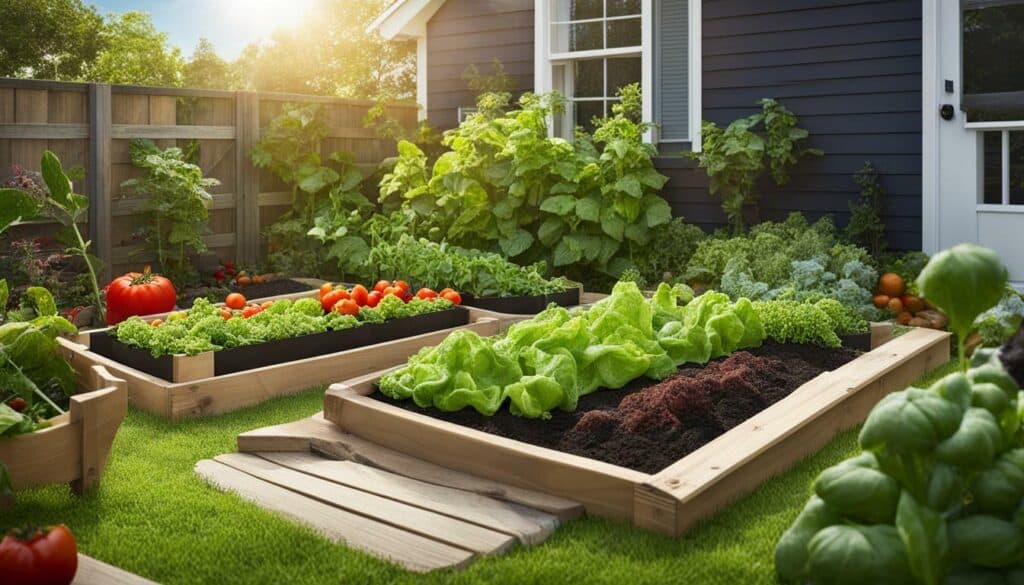
Preparing the Soil for Healthy Growth
Before planting your first seed or seedling, it’s important to prepare the soil properly to provide a nourishing foundation for your plants to thrive. As a novice gardener, it’s essential to equip yourself with the right tools to make the process seamless and enjoyable.
| Essential Tools for First-time Gardeners |
|---|
| Gardening gloves |
| Trowel |
| Garden fork |
| Compost bin |
| Wheelbarrow |
Adding organic matter to the soil can enhance its texture, improve water retention, and provide essential nutrients for plants to grow. Organic matter can be added to the soil by incorporating composted manure, grass clippings, shredded leaves, and other decaying plant material.

It’s also essential to understand the movement of the sun throughout the day to determine the best location for the garden. Plants require sunlight to grow, and it’s recommended to choose a location that receives at least six hours of direct sunlight per day. Additionally, choosing plants that are suitable for the climate and soil type can ensure that they thrive in the garden.
If you’re new to gardening, it’s recommended to start small and add more plants gradually. Using seedlings or starter plants for plants that are difficult to grow from seeds can also help streamline the process.
Lastly, keeping a gardening journal can be a useful tool for tracking successes and failures, recording plant growth, and noting any necessary adjustments for future planting.
Sowing Seeds vs. Using Seedlings
As a first-time gardener, you may wonder whether to start your garden from seeds or opt for ready-to-plant seedlings. Depending on the plant and your level of experience, either option can be suitable. Sowing seeds allows you to start small and grow your garden alongside your knowledge and experience. It’s crucial to research which plants are well-suited for your climate and learn about their specific needs before purchasing seeds. Location plays a major role, as plants may require different levels of sunlight and water.
Preparing the soil is essential for healthy growth. By adding organic matter, you can create a nutrient-rich environment for your plants. However, some plants may prove challenging to grow from seeds and require more attention. In these cases, using seedlings can be a convenient option. Plants like tomatoes, peppers, and petunias are easier to grow from seedlings, which are more expensive but save time and bypass potential mistakes.
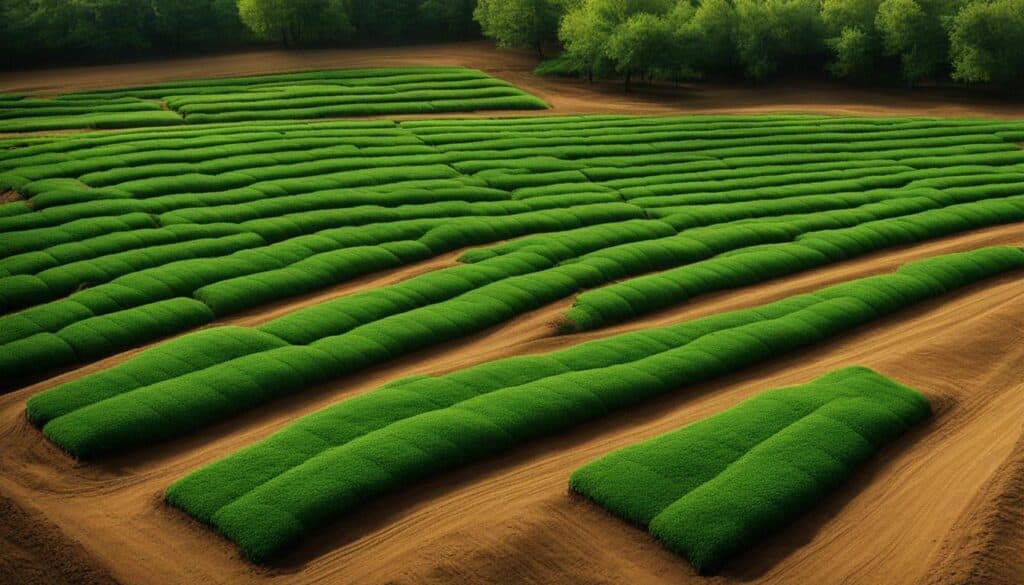
Keeping track of your gardening journey through a journal is also recommended to track successes and failures and find the best methods for future gardening endeavors. No matter which option you choose, embracing eco-friendly practices in gardening is another important aspect. This includes using sustainable materials, practicing organic gardening, conserving water, planting for biodiversity, and growing your own plants. By following these guidelines, gardeners can contribute to a more sustainable and environmentally friendly approach to gardening.
Keeping Track of Your Gardening Journey
One valuable practice for first-time gardeners is to keep a gardening journal, recording your experiences, observations, and lessons learned along the way. Starting with a small garden and researching regional plant suitability are important first steps towards success. Finding the right location, with enough sunlight and water accessibility, is crucial.
Preparing the soil by adding organic matter creates a favorable environment for plants to grow. For novice gardeners, using seedlings instead of seeds can be a time-saver. Keeping a gardening journal can help track successes and failures and become a tool for learning.
When practicing eco-friendly gardening, opt for sustainable practices like organic gardening and conserving water through rainwater harvesting systems and drip irrigation. Companion planting to deter pests and improve pollination and using renewable energy are also vital. Choose native plants, encourage biodiversity, minimize waste, and incorporate permaculture principles and integrated pest management. Using sustainable planters and organic soil, planting for wildlife, and growing your own plants are other eco-friendly practices to adopt.
Incorporating these tips can contribute to a more sustainable and rewarding gardening experience while promoting environmental preservation. By keeping track of your gardening journal, you can reflect on your progress, learn from your experiences, and be proud of the work you’ve done.
Going Organic: A Greener Approach
Embracing organic gardening is not only better for the environment but also promotes healthier and more sustainable plant growth. As a first-time gardener, going organic is a great approach to consider. By avoiding synthetic fertilizers, pesticides, and herbicides, you can create a healthier and more eco-friendly garden.
There are many ways to practice organic gardening, including using natural alternatives for fertilizing, pest control, and conserving water. Composting is an excellent way to produce nutrient-rich soil for your plants. By composting your kitchen scraps and yard waste, you can create a natural and sustainable source of plant food.
Conserving water is another crucial aspect of organic gardening. By installing a rainwater harvesting system to collect rainwater for watering plants and using drip irrigation or soaker hoses, you can minimize water wastage through evaporation.
Companion planting is another sustainable gardening technique that can promote plant health and biodiversity. By growing compatible plant species together, you can deter pests, improve pollination, and optimize space utilization.
Choosing native plant species adapted to the region’s climate and soil conditions is crucial for a sustainable garden. Native plants generally require less water, are more resistant to pests and diseases, and provide essential habitats for local wildlife.
Promoting biodiversity by incorporating various plants, flowers, and shrubs attracts beneficial insects, birds, and other wildlife, which promotes pollination and natural pest control.
Minimizing waste by reusing and repurposing materials in the garden, such as using recycled containers for planting and repurposing old furniture as garden accents, reduces the impact on the environment.
Implementing permaculture principles, such as creating self-sustaining plant guilds, building composting systems, and utilizing organic mulch, helps conserve water and nurture a balanced garden ecosystem.
Using renewable energy, such as solar energy to power garden tools and lighting, reduces carbon footprint and provides long-term cost savings.
Adopting an integrated pest management approach to control pests effectively involves a combination of preventive measures, biological controls, and targeted pesticide applications only when necessary.
By incorporating these sustainable practices, gardening becomes a greener approach that minimizes environmental impact, promotes biodiversity, and creates thriving ecosystems.
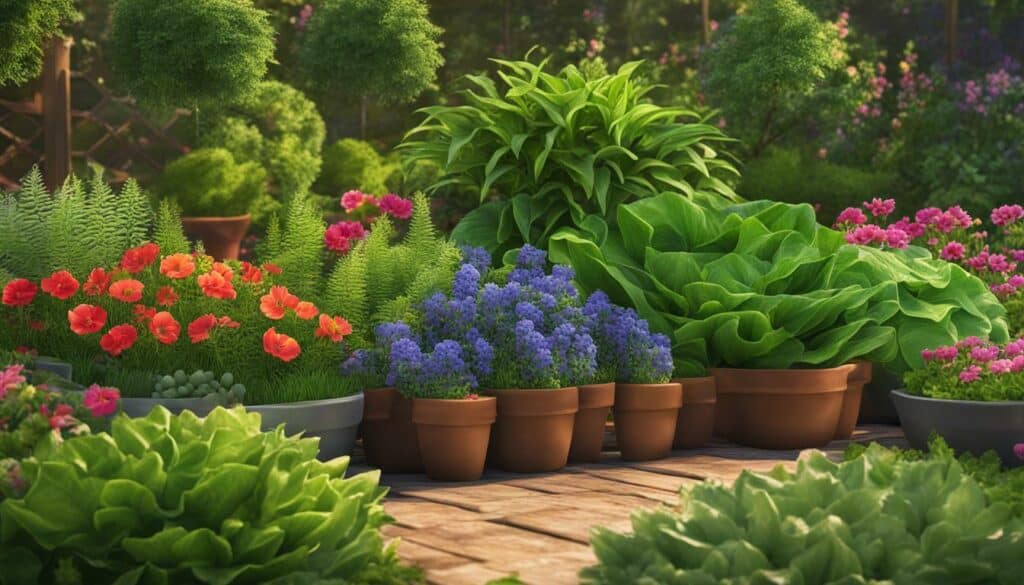
Water Conservation Techniques
Conserving water is crucial for successful gardening, and as a first-time gardener, there are several techniques you can employ to reduce water usage and maintain a sustainable garden.
- Install a Rainwater Harvesting System: Collecting rainwater is an excellent way to reduce dependence on municipal water supplies and reduce water costs. Rain barrels or cisterns can be used to store water for later use in watering your garden.
- Use Drip Irrigation or Soaker Hoses: Drip irrigation delivers water directly to roots, minimizing evaporation, and reducing water usage. Soaker hoses are also an excellent option for maintaining an even distribution of water in your garden.
- Choose Native Plants: Native plant species are adapted to local climate and soil conditions, requiring less water than non-native plants. Incorporating native plants in your garden can help reduce water usage, while also providing essential habitats for local wildlife.
- Practice Companion Planting: Companion planting involves planting species together that complement each other’s growth patterns and nutrient needs, resulting in healthier plants with more efficient water usage. For example, planting beans alongside corn provides both plants with mutual benefits as beans fix nitrogen in the soil, which corn uses for growth.
- Embrace Organic Gardening: Chemical fertilizers and pesticides can have adverse effects on the environment and disrupt the balance of your garden’s ecosystem. Using natural alternatives such as compost, manure, or organic pest control methods can help reduce water usage and promote sustainable gardening practices.
- Encourage Biodiversity: Incorporating a diverse range of plants, flowers, and shrubs can attract beneficial insects, such as bees and butterflies, which promote pollination and natural pest control. This can reduce water usage by minimizing the need for chemical pesticides and fertilizers.
- Minimize Waste: Reusing and repurposing materials in your garden, such as using fallen leaves as mulch, can help reduce water usage by promoting soil health and water retention. Using recycled containers for planting, and recycling or composting garden waste, can also minimize environmental impact.
- Practice Integrated Pest Management (IPM): Using a combination of preventive measures, biological controls, and targeted pesticide applications only when necessary is an effective way to control pests while minimizing water usage and reducing environmental impact.
- Use Renewable Energy: Consider utilizing solar energy to power your garden tools and lighting. Solar power can be a cost-effective and environmentally friendly way to reduce your garden’s carbon footprint and long-term energy costs.
Implementing these water conservation techniques and sustainable practices can help minimize environmental impact, promote biodiversity, and create a thriving, eco-friendly garden.
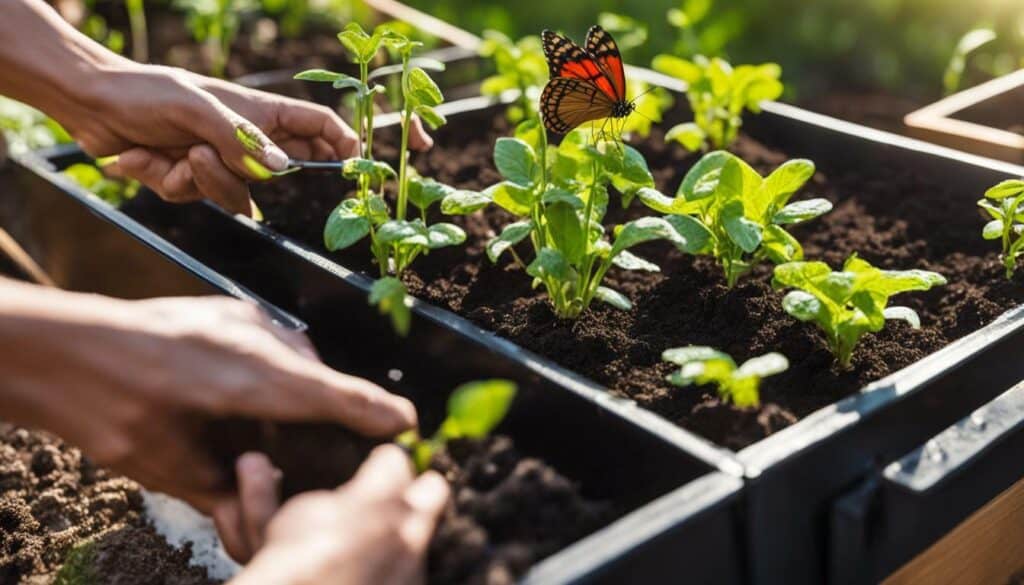
Companion Planting for Pest Control and Pollination
Companion planting is an age-old practice that involves strategically placing certain plants together to enhance growth, improve pest resistance, and foster better pollination. This eco-friendly technique helps gardeners create a thriving ecosystem by promoting biodiversity and reducing the need for synthetic pesticides and herbicides.
Gardeners can choose from a variety of companion planting techniques, such as planting herbs with vegetables or pairing certain flowers together. For example, planting marigolds with vegetables can naturally repel harmful insects, while attracting beneficial insects and birds that aid in pollination. Similarly, planting beans alongside corn can help fix nitrogen in the soil, benefiting both plants.
Companion planting can also help control garden pests without the use of harmful chemicals. For example, planting basil alongside tomato plants can help repel tomato hornworms, while planting onions with carrots can deter carrot flies.
By embracing companion planting, novice gardeners can improve their gardening skills and create a more sustainable ecosystem in their garden. To further support an eco-friendly approach, gardeners can also embrace organic gardening practices, such as using compost and natural pest control methods. Conserving water, choosing native plants, and incorporating permaculture principles are other strategies to promote beginner-friendly and basic gardening techniques for eco-friendly gardening.

“Companion planting can help control garden pests without the use of harmful chemicals.”
Harnessing the Power of Compost
Compost is often referred to as “black gold” for gardeners, and as a first-time gardener, learning to harness the power of compost can greatly enhance the health and productivity of your garden.
Composting is a simple and inexpensive way to recycle organic waste, reduce waste sent to landfills, and create a nutrient-rich soil amendment for your garden. By composting kitchen scraps, leaves, grass clippings, and other organic materials, you can easily create a rich soil amendment that helps plants grow and thrives.
When incorporating compost into your garden, it is important to remember that not all compost is created equal. Some compost may contain ingredients that are harmful to plants or could introduce pests and diseases into your garden. To ensure that you are using high-quality compost, consider purchasing compost from a reputable source or make your compost using a balanced mixture of brown and green materials.
Adding compost to your soil provides several benefits, including improving soil structure, increasing fertility, and retaining moisture. As compost decomposes, it breaks down into nutrient-rich particles that enrich the soil and promote healthy plant growth. Additionally, compost helps to loosen clay soils and improve the water retention of sandy soils, creating a more hospitable environment for plants to grow.
Aside from its benefits for soil health, composting is also an eco-friendly practice that promotes sustainability in gardening. By reducing waste sent to landfills and using natural alternatives to synthetic fertilizers, pesticides, and herbicides, gardeners can contribute to the preservation of the planet.
Consider incorporating compost into your gardening journey and experience the benefits of “black gold” firsthand. With proper research and planning, and by following eco-friendly practices, you can create a thriving ecosystem that benefits both your garden and the environment.

Remember to start small with an herb garden or a single type of seed and gradually expand based on knowledge and experience. Proper research into plants that thrive in specific climates, finding suitable locations with adequate sunlight and easy access to water sources, and keeping a gardening journal to track successes and failures are all essential steps.
In summary, composting is a valuable practice that helps to improve soil health, reduce waste, conserve water, and promote sustainability in gardening. By incorporating compost into gardens and following eco-friendly practices, gardeners can create thriving ecosystems that benefit both them and the environment.
Creating a Thriving Ecosystem
As a first-time gardener, you have the opportunity to create a thriving ecosystem in your own backyard by carefully selecting native plants, fostering biodiversity, and promoting a healthy environment for wildlife. By implementing a few eco-friendly gardening practices, you can turn your garden into a haven for birds, bees, butterflies, and other pollinators.
One of the easiest ways to encourage wildlife in your garden is to choose plants that are native to your region. Native plants are adapted to the local climate and soil conditions, which means they require less water and care. They also provide a natural habitat for local wildlife, including insects, birds, and small animals. Consider adding a variety of plants to your garden, including trees, shrubs, and flowers that bloom at different times throughout the year.
Biodiversity is another key factor in creating a healthy ecosystem. By incorporating a mix of plant types, you can attract a wider range of pollinators and beneficial insects to your garden. Companion planting is a great way to encourage biodiversity, as some plants have natural pest-repelling properties and can help to support the growth of neighboring plants. For example, planting marigolds alongside tomatoes can help to deter pests and attract bees.
Composting is another essential practice for any eco-friendly gardener. By recycling kitchen and garden waste, you can create a nutrient-rich soil amendment that will nourish your plants and improve soil health. Compost can also help to retain moisture in the soil, reducing the need for watering. Consider investing in a compost bin or setting up a small compost pile in your garden.
Finally, it’s important to minimize waste and use sustainable gardening practices whenever possible. This can include using renewable energy sources for garden lighting and irrigation, practicing integrated pest management techniques to reduce the need for synthetic pesticides, and incorporating permaculture principles into your garden design.
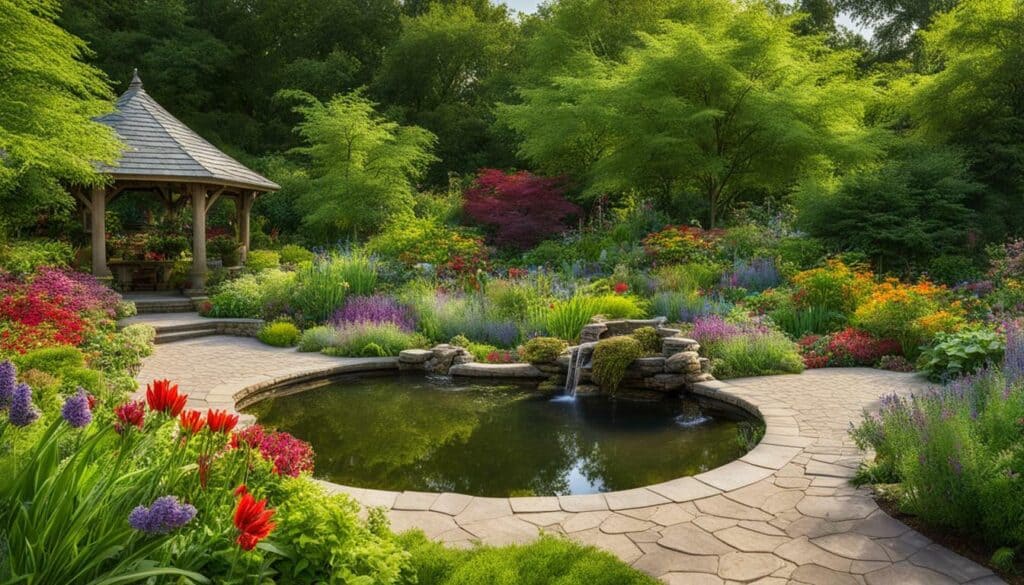
By taking a holistic approach to gardening and embracing sustainable practices, you can create a beautiful and thriving ecosystem in your own backyard. With a little effort and patience, you can help to preserve the planet for future generations to enjoy.
Conclusion
Congratulations on taking the first steps towards becoming a successful gardener! By following these tips and embracing green living, you are well on your way to creating your own haven of flourishing plants and a sustainable lifestyle. Remember to start small, do your research, and choose the right location and plants for your garden. Preparing the soil with organic matter, using seedlings, and keeping a gardening journal are all helpful practices for cultivating and maintaining a thriving garden.
In addition to these tips, it’s important to consider sustainable gardening practices to minimize your environmental impact. Embracing organic practices, conserving water, practicing companion planting, and using renewable energy are all essential ways to promote eco-friendly gardening. Encouraging biodiversity, minimizing waste, incorporating permaculture principles, and practicing integrated pest management are other key steps towards achieving a more sustainable garden.
By prioritizing both the health of your garden and the health of the planet, you can create a beautiful and sustainable garden that benefits not only you but also the environment. So, go ahead and plant those seeds, tend to those plants, and watch your garden grow into a thriving ecosystem of its own. Happy gardening!
What Are Some Essential Gardening Tips for Beginners?
Whether you’re eager to cultivate a green thumb or simply interested in trying your hand at gardening, these essential green thumb gardening tips will set you on the right path. Start by choosing the right soil type, watering your plants properly, and giving them enough sunlight. Don’t forget to research the specific needs of each plant and provide regular care. With practice and patience, you’ll soon witness your garden flourish.
What Are the Simple Steps to Becoming a First-Time Gardener?
To be a successful gardener, start by choosing plants suited to your local climate and soil type. Prepare the soil by removing weeds and adding organic matter. Next, plan your garden layout and spacing, ensuring each plant has enough room to grow. Regularly water and fertilize your plants, and protect them from pests and diseases. Lastly, harvest your crops at the right time, and remember to enjoy the process of nurturing your garden.
FAQ
Q: How do I start a garden if I’m a beginner?
A: It’s best to start with a small garden to avoid feeling overwhelmed. Choose easy-to-grow plants and do some research on what plants are well-suited for your climate and needs.
Q: Where should I place my garden for success?
A: Select a location that receives adequate sunlight and is easily accessible for watering. Ensure that the location is suitable for the plants you want to grow.
Q: How do I prepare the soil for my garden?
A: To create a nutrient-rich environment, add organic matter to the soil. This can include compost or other organic amendments that will improve soil health and fertility.
Q: Should I use seeds or seedlings?
A: It depends on the plant. Some plants are easier to grow from seedlings, while others can be grown from seeds. Consider using seedlings for plants that are more difficult to grow from seeds.
Q: How can I keep track of my gardening progress?
A: Keeping a gardening journal is a great way to track your successes and failures. It can serve as a reference for future gardening endeavors and help you learn from your experiences.
Q: How can I practice organic gardening?
A: Embrace organic gardening by avoiding synthetic fertilizers, pesticides, and herbicides. Instead, use natural and organic alternatives to promote a healthier and more sustainable garden.
Q: How can I conserve water in my garden?
A: You can conserve water by implementing rainwater harvesting systems and using drip irrigation. These techniques help to minimize water waste and ensure your plants receive the right amount of water.
Q: How can I deter pests without using harmful chemicals?
A: Practice companion planting, which means planting certain plants together to naturally deter pests and improve pollination. This can help create a more balanced and eco-friendly garden.
Q: What are some beginner-friendly plants for my garden?
A: Choose native plants adapted to your region’s climate and soil conditions. These plants are more likely to thrive and require less maintenance, making them ideal for beginners.
Q: How can I minimize waste in my garden?
A: Minimize waste by recycling and repurposing materials whenever possible. This can include using sustainable planters and landscaping materials made from recycled materials.
Q: Should I incorporate permaculture principles in my garden?
A: Yes, incorporating permaculture principles can maximize efficiency in your garden. This can involve using renewable energy, such as solar power, for garden tools and lighting.
Q: How can I effectively control pests in my garden?
A: Practice integrated pest management, which involves a combination of preventive measures, physical barriers, and safer pest control methods to keep pests at bay.
Q: How can I ensure my garden is environmentally friendly?
A: Use sustainable practices in your garden, such as choosing organic soil and compost, planting for wildlife and biodiversity, and growing your own plants to have control over their origins and avoid harmful chemicals.
Source Links
- https://blog.embracehomeloans.com/tips-for-new-gardeners/
- https://www.ecogardeners.com/gardening-landscaping-tips-info/eco-gardening-tips-for-greener-garden/
- https://www.fertilefibre.com/blogs/blog/sustainable-gardening-ideas
- https://www.nancybirtwhistle.co.uk/my-books/
- https://www.amazon.com/First-time-Gardener-Vegetables-encouragement-First-Time/dp/0760368724
- https://www.amazon.com/First-Time-Gardener-know-how-eco-friendly-Gardeners/dp/0760368740
- https://www.dreamley.com/avoiding-overwhelm-first-time-gardener/
- https://joegardener.com/podcast/reducing-garden-overwhelm/
- https://www.themiddlesizedgarden.co.uk/feeling-overwhelmed-by-your-garden-11-easy-practical-solutions/
- https://www.gardeningetc.com/advice/best-plants-for-beginners
- https://www.homesandgardens.com/gardens/best-plants-for-beginners
- https://www.lonelypinesfarm.com/top-25-easy-plants-for-beginner-gardeners/
- https://growitbuildit.com/14-factors-to-choose-your-vegetable-garden-location/
- https://www.gardensthatmatter.com/choose-garden-location/
- https://www.almanac.com/where-put-vegetable-garden
- https://www.almanac.com/soil-preparation-how-do-you-prepare-garden-soil-planting
- https://www.planetnatural.com/garden-soil/
- https://www.wikihow.com/Prepare-the-Soil-for-a-Vegetable-Garden
- https://savvygardening.com/start-from-seed-or-buy/
- https://www.thespruce.com/vegetable-garden-seeds-or-seedlings-1403412
- https://www.millcreekgardens.com/seeds-vs-plant-nursery-seedlings-which-is-best-for-a-new-garden/
- https://food52.com/blog/26192-garden-record-keeping
- https://sohospark.com/blogs/news/12-essential-things-to-track-in-your-gardening-journal
- https://www.seattletimes.com/pacific-nw-magazine/track-your-plants-your-progress-and-even-your-problems-in-a-personalized-gardening-journal/
- http://www.greenfootsteps.com/organic-gardening.html
- https://www.thespruce.com/organic-gardening-7511316
- https://ecogardener.com/blogs/news/eco-friendly-tips-for-your-organic-vegetable-garden
- https://extension.unh.edu/blog/2018/06/water-conservation-fundamentals-gardening-landscaping
- https://www.groworganic.com/blogs/articles/water-conservation-tips-in-vegetable-gardens
- https://cmg.extension.colostate.edu/Gardennotes/716.pdf
- https://www.al.com/living/2016/04/companion_planting_can_be_a_fo.html
- https://www.almanac.com/companion-planting-guide-vegetables
- https://gardening.org/best-companion-plants-to-grow-for-natural-pest-control/
- https://www.udel.edu/academics/colleges/canr/news/2022/september/let-it-rot/
- https://www.soilpluskona.com/post/organic-gardening-101-the-role-of-compost-in-boosting-soil-health
- https://victorygardengal.com/4-easy-steps-to-starting-a-compost-for-your-victory-garden/
- https://www.ecosystemgardening.com/5-pillars-of-ecosystem-gardening.html
- https://empressofdirt.net/ecological-gardening-principles-to-grow-by/
- https://alamedabackyardgrowers.org/creating-a-sustainable-ecosystem-in-your-garden/
- https://www.ipl.org/essay/My-Experience-Of-Gardening-My-First-Garden-PKCXA8HESCPR
- http://lizfabry.blogspot.com/2012/11/garden-update.html?m=1
- https://www.bhg.com/gardening/yard/garden-care/ten-steps-to-beginning-a-garden/





Leave a Reply